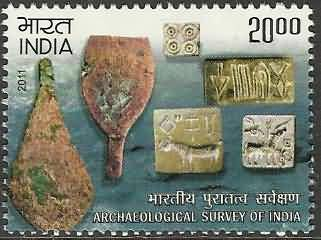Archaeological Survey of India- Stonecarvings

Technical Data
| Stamp Set | Archaeological Survey of India |
|---|---|
| Date of Issue | December 20, 2011 |
| Denomination | Rs. 20 |
| Quantity | 400,000 |
| Perforation | 13 |
| Printer | Security Printing Press, Hyderabad |
| Printing Process | Wet Offset |
| Watermark | No Watermark |
| Colors | Multicolor |
| Credit (Designed By) | Shri Kamleshwar Singh Smt. Alka Sharma |
| Catalog Codes |
Michel IN 2634 Stanley Gibbons IN 2852 WADP Numbering System - WNS IN058.2011 |
| Themes | Anniversaries and Jubilees | Archaeology | Coins | Rock Art and Cave Paintings |
Archaeology, even as it engages with the human past, is a modern pursuit that fosters productive harmony between the society and its heritage. Learning from the peoples of the past and their relationship with the environment is now more than ever relevant than in India, a continent like country with its bewildering diversities and contradictions, and which is often described as living simultaneously in different centuries.
The task of protecting the cultural heritage of the nation has been entrusted to the Archaeological Survey of India (ASI), an organization functioning under the Department of Culture of the Government of India. Activities of the ASI include archaeological research, scientific analysis, excavation of buried remains, conservation of protected monuments and areas of national importance, maintenance of site museums and regulation of construction activities around the sites and monuments.
The scientific study of India and its past began towards the end of eighteenth century. The initial efforts having been inspired by the accounts of earlier visitors like Yuan Chwang, saw its landmark with the arrival of Sir William Jones and the subsequent formation of the Asiatic Society in 1784 gave a major fillip to the discipline. These early archaeological ventures were institutionalised with the setting up of the ASI in 1861. Legendary archaeologists like Alexander Cunningham, John Marshall and Mortimer Wheeler contributed to the emergence of the Survey as a prominent voice in the building and generation of knowledge.
The distribution of the sites and monuments protected by ASI is immense, spread across different ages and spread throughout the length and breadth of the nation. The ASI has protected about 3650 monuments of different types; and, this diversity is a clear reflection of India’s unity and culture emerging through its multi-layered history. Seen in this sense, these protected sites and monuments mark a heritage for future generations. The heritage sites and monuments under ASI’s charge are in an immense variety, and include palaces, temples, mosques, churches, monasteries, stupas, step-wells, megaliths, pillars, kos-minars, tombs, cemeteries, sarais, rock shelters, with their prehistoric paintings and rock-cut caves, belonging to prehistoric, proto-historic, historic, medieval and colonial period. These monuments and sites are located in different bio-geographical zones, from the snow heights of the Himalayas to coastal Tamil Nadu in the south.
The ASI is, in this sense, called upon to face challenges of conservation, which are different with different types of heritage, cultural heritage, depending upon geographical zones and human responses. With what is now recognized as intangible heritage and its interface with tangible heritage, ASI faces newer challenges and requires application of new knowledge systems. The ASI has, however, managed to build a great experience and pool of trained professionals, to meet the task of heritage conservation. Conservation is now no longer seen as an activity limited to only monuments and archaeological sites. It now encompasses issues related to the environment, development, land use problems to the community.
Despite the challenges and limitations, the ASI is serving the cause of heritage preservation and nation building for 150 years with the issue of a set of two postage stamps.
First Day Cover

